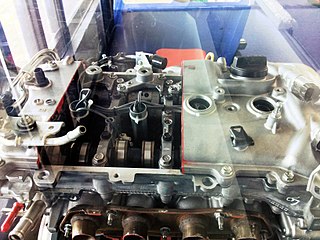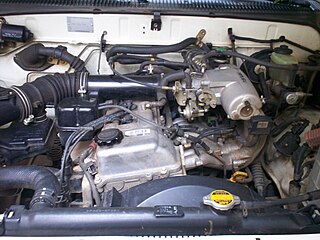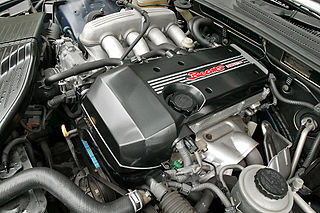
VVT-i, or Variable Valve Timing with intelligence, is an automobile variable valve timing petrol engine technology manufactured by Toyota Group and used by brands Groupe PSA, Toyota, Lexus, Scion, Daihatsu, Subaru, Aston Martin, Pontiac and Lotus Cars. It was introduced in 1995 with the 2JZ-GE engine found in the JZS155 Toyota Crown and Crown Majesta.
The GM Ecotec engine, also known by its codename L850, is a family of all-aluminium inline-four engines, displacing between 1.2 and 2.5 litres. Confusingly, the Ecotec name was also applied to both the Buick V6 Engine when used in Holden Vehicles, as well as the final DOHC derivatives of the previous GM Family II engine; the architecture was substantially re-engineered for this new Ecotec application produced since 2000. This engine family replaced the GM Family II engine, the GM 122 engine, the Saab H engine, and the Quad 4 engine. It is manufactured in multiple locations, to include Spring Hill Manufacturing, in Spring Hill, Tennessee, with engine blocks and cylinder heads cast at Saginaw Metal Casting Operations in Saginaw, Michigan.

The Toyota JZ engine family is a series of inline-6 automobile engines produced by Toyota. As a replacement for the M-series inline-6 engines, the JZ engines were 24-valve DOHC engines in 2.5- and 3.0-litre versions.

The Toyota AZ engine family is a straight-4 piston engine series. The AZ series uses an aluminium engine block with cast iron cylinder liners and aluminium DOHC cylinder head. The engine series features many advanced technologies including slant-squish combustion chambers, offset cylinder and crank centers, and the VVT-i continuously variable intake valve timing system. The aluminium engine measures 626 mm (24.6 in) long, 608 mm (23.9 in) wide, and 681 mm (26.8 in) tall.

The Toyota RZ engine family is a straight-four piston engine series built in Japan. The RZ series uses a cast-iron engine block and aluminum SOHC or DOHC cylinder heads. It has electronic fuel injection (EFI), 2 or 4 valves per cylinder and features forged steel connecting rods.

The Toyota MZ engine family is a piston V6 engine series. The MZ series has an aluminium engine block and aluminium alloy DOHC cylinder heads. The cylinders are lined with cast iron, and is of a closed deck design. The engine is a 60 degree V6 design. It uses multi-port fuel injection (MFI), four valves per cylinder, a one-piece cast camshaft and a cast aluminium intake manifold. The MZ family is a lightweight V6 engine of an all-aluminium design, using lighter weight parts than the heavier duty VZ block engines in an effort to lower production costs, decrease engine weight, and decrease reciprocating weight without sacrificing reliability. Toyota sought to enhance the drivability pattern of the engine at exactly 3000 rpm, since that was the typical engine speed for motors cruising on the highway. The result was less cylinder distortion coupled with the decreased weight of rotating assemblies, smoother operation at that engine speed, and increased engine efficiency.

The Toyota UZ engine family is a gasoline fueled 32-valve quad-camshaft V8 piston engine series used in Toyota's luxury offerings and sport utility vehicles. Three variants have been produced: the 1UZ-FE, 2UZ-FE, and 3UZ-FE. Production spanned 24 years, from 1989 to mid 2013, ending with the final production of the 3UZ-FE-powered Toyota Crown Majesta I-FOUR. Toyota's UZ engine family was replaced by the UR engine family.

The Lexus LFA is a two-door sports car produced between 2010 and 2012 by the Japanese carmaker Toyota under its luxury marque, Lexus. Lexus built 500 units over its production span of two years.

The Toyota S Series engines are a family of straight-four petrol engines with displacements between 1.8 and 2.2 litres, produced by Toyota Motor Corporation from January 1980 to August 2007. The S series has cast iron engine blocks and aluminium cylinder heads. This engine was designed around the new LASRE technology for lighter weight – such as sintered hollow camshafts.

The Toyota HD is a series of Diesel engines produced by Toyota.

The Toyota UR engine family is a 32-valve dual overhead camshaft V8 piston engine series which was first introduced in 2006, as the UZ series it replaced began phasing out. Production started with the 1UR-FSE engine with D-4S direct injection for the 2007 Lexus LS. The series launched with a die-cast aluminum engine block, aluminum cylinder heads and magnesium cylinder head covers. All UR engines feature variable valve timing for both intake and exhaust cams or Dual VVT-i. Timing chains are used to drive the camshafts. The UR engine has been produced in 4.6, 5.0, and 5.7-liter displacement versions.

The Suzuki GSX-R1000 is a sports motorcycle made by Suzuki. It was introduced in 2001 to replace the GSX-R1100 and is powered by a liquid-cooled 999 cc (61.0 cu in) inline four-cylinder, four-stroke engine although originally 988 cc (60.3 cu in) from 2001 to 2004.

The Mitsubishi 4B1 engine is a range of all-alloy straight-4 piston engines built at Mitsubishi's Japanese "World Engine" powertrain plant in Shiga on the basis of the Global Engine Manufacturing Alliance (GEMA). Although the basic designs of the various engines are the same, their exact specifications are individually tailored for each partner. The cylinder block and other basic structural parts of the engine were jointly developed by the GEMA companies, but the intake and exhaust manifolds, the cylinder head's intake and exhaust ports, and other elements related to engine tuning were independently developed by Mitsubishi.

The ZR engine is a family of straight-four 16-valve all-aluminum and water cooled gasoline engines with a die-cast aluminum block and variable valve timing developed by Toyota Motor Corporation, produced from 2007. Engines displace from 1.6 to 2.0 liters. Most engines in this family are equipped with Toyota's dual VVT-i technology that optimizes both intake and exhaust valve timing. This engine family is also the first to use Toyota's Valvematic system, first appearing on the Noah and Voxy in 2007 and then the European Avensis in 2009.

The Lexus F and F-Sport marque is the high-performance division of cars produced by Lexus. The F is short for flagship and Fuji Speedway, the chief test site of Lexus performance vehicle development in Oyama, Suntō District, Shizuoka Prefecture, Japan.

The AR engine family is an Inline-4 piston engine series by Toyota, first introduced in 2008 for the RAV4, and subsequently for the Highlander, Venza, Camry and Scion tC.
The GMA is a 4.0-litre, naturally aspirated V12 engine, commissioned by Gordon Murray, and developed and produced by Cosworth for the Gordon Murray Automotive T.50 & T.33 sports cars. The road-going engine is rated at 663 PS at 11,500 rpm, with a max torque figure of 467 N⋅m (344 lbf⋅ft) at 9,000 rpm, making it the highest revving road car engine ever produced. The engine is also more powerful than the 6.1 L (6,064 cc) S70/2 V12 engine used in the McLaren F1.

















